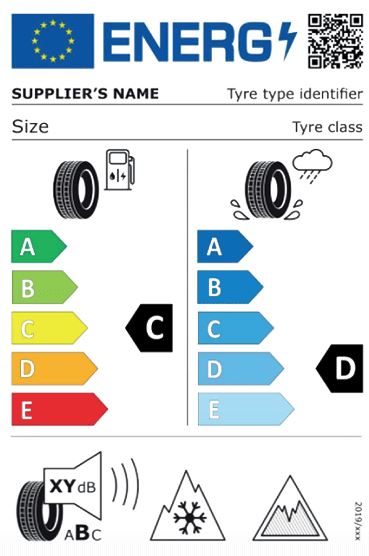Tyre Labelling
All new tyres we supply for cars, vans and 4x4s come with EU Tyre Labels.
The labels, mandated in 2012, provide information to help buyers make an informed tyre choice. The labelling covers fuel efficiency, braking distance in wet road conditions, and exterior noise. In 2021, the EU Tyre Label was amended to help consumers to be better informed when buying new tyres.
Tyres that don’t have the EU tyre labels include off-road, vintage, spare, studded, racing tyres and those with a speed limit of up to 80km/h.
Why do we need EU Tyre labels?
EU tyre labels are designed to help drivers who regularly take motorway trips or travel long trips in different weather conditions, to know how well their tyres can handle poor road conditions.
What do EU Tyre labels look like?
The tyre rating labels are shown in their respective sections below with more information each.
1 – Fuel Efficiency

Tyres have a fuel efficiency rating from A (most fuel-efficient) to E (least fuel efficient).
The better the fuel efficiency, the lower the cost of motoring and the less harmful Carbon Dioxide pumped into the atmosphere.
Choosing A-rated tyres over E-rated tyres equates to a 7.5% saving in fuel.
An A-rated tyre may use 80 litres less fuel each year (over £110) compared to when using E-rated tyres. This estimate is based on a petrol engine covering 10,000 miles at a cost of £1.40 for every litre of petrol.
Rolling resistance
Tyres indirectly use a fifth of their fuel consumption due to something called ‘rolling resistance’. This is the friction created when the tyres touch the road. Each tyre has a different amount of rolling resistance depending on its shape and composition. They use less fuel and cost less to own.
2 – Wet Grip & Braking Distances

Tyres struggle to grip the road to slow down in wet road conditions, so manufacturers change tyre patterns to improve braking times and reduce the chance of aquaplaning.
Tyres are rated for their combined wet grip and braking distance rating – how long it takes for the vehicle to come to a complete stop in wet road conditions.
All-weather tyres can be used when weather is poor for many weeks and we stock a range of these to suit many types of vehicles.
The EU tyre labels helps drivers choose the tyre with the shortest stopping distance.
Braking distance variation between each wet weather tyre rating from A to E, equates to 3-6 metres. The maximum benefit is 18 metres shorter braking distance based on driving at 50mph in wet road conditions when choosing A-rated tyres over E-rated ones.
3 – External Noises

External noise emissions measure the decibels (dB) created outside the vehicle when that tyre is used in normal driving conditions.
Tyres have a tyre noise rating label from A (less noise outside the vehicle) to C (increased noise outside the vehicle). The exact dB will be shown on the tyre label.
Are the labels standardised across Tyre brands?
Whether you’re looking at Michelin, Continental or other tyre brands, the label information can be compared side-by-side.

